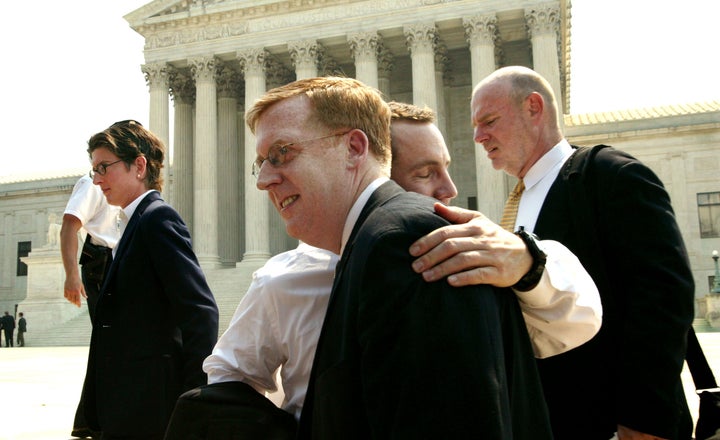
With the nomination of Judge Neil Gorsuch to serve on the Supreme Court of the United States instead of Judge Merrick Garland, and with the possibility of another Trump Supreme Court nomination at some point down the road, it is useful to reflect on the history of homosexuality in Western culture and on the pivotal role the Supreme Court has played in helping to shape our nation’s laws in this regard.
The plain and simple fact is that, with two Trump appointments to the Supreme Court, should that come to pass, we can expect significant changes in the way the Court approaches the rights of gays and lesbians in the future. Before we get to that point, it is important to understand how we got to where we are today. It is only with that understanding that we can truly comprehend the magnitude of the challenge ahead. In my first two pieces in this series (which I have decided to expand to four posts rather than three), I discussed the history of homosexuality from the ancient world through the 1990s. See part 1 and part 2.
In this, the third piece in the series, I will discuss the role of the Supreme Court in addressing the constitutionality of laws making sodomy a criminal offense. Each of these posts, I should note, is drawn in part from my forthcoming book, Sex and the Constitution. I hope you will find this history instructive.
***
In August 1982, an Atlanta police officer went to the home of Michael Hardwick to serve an arrest warrant for public drinking. Upon entering the home, the officer observed Hardwick and another man engaged in oral sex. The officer placed both men under arrest for the crime of sodomy.
In Bowers v. Hardwick, decided in 1986, the Supreme Court held that Georgia’s prohibition of homosexual sodomy was not unconstitutional. Noting that the Constitution says nothing about a right to commit sodomy, and that proscriptions against homosexuality “have ancient roots,” Justice Byron White, who had been appointed to the Court by President Kennedy, and who wrote the majority opinion, concluded that, to claim that the Constitution protects “a right to engage in such conduct . . . is, at best, facetious.”
In a concurring opinion, Chief Justice Warren Burger added that condemnation of homosexual conduct “is firmly rooted in Judeo-Christian moral and ethical standards” and that “to hold that the act of homosexual sodomy” was somehow protected by the Constitution “would be to cast aside millennia of moral teaching.”
Justice Harry Blackmun, joined by Justices Brennan, Marshall, and Stevens, dissented. Although conceding that “traditional Judeo-Christian values” had proscribed homosexual intimacy for hundreds, if not thousands, of years, Blackmun insisted that that fact “cannot provide an adequate justification” in itself for the Georgia law. “That certain . . . religious groups condemn the behavior at issue,” he reasoned, “gives the State no license to impose their judgments on the entire citizenry.”
To the contrary, “the legitimacy of secular legislation” depends on “whether the State can advance some justification for its law beyond its conformity to religious doctrine.” Finding no such justification, Blackmun concluded that the Georgia statute could not be reconciled with the United States Constitution. This, however, was a dissenting opinion.
The Supreme Court’s second decision involving the constitutionality of laws making sodomy a criminal offense, Lawrence v. Texas, was pretty much a re-run of Bowers. Police officers in Houston were dispatched to a private residence in response to a reported disturbance. After they entered the residence, they saw two men engaging in anal sex. The men were arrested, charged, and convicted of violating a Texas statute making it a crime for any person to engage “in deviate sexual intercourse with another individual of the same sex.”
Since 1986, Bowers had been used by politicians, legislators, and judges to justify discrimination against gays and lesbians in deportation hearings, adoption proceedings, military discharges, employment discrimination, and a host of other contexts. After all, if homosexual conduct is criminal, than a homosexual is no different than a rapist, a robber, or a thief.
Much had changed, however, in the 17 years between Bowers and Lawrence. Not only had AIDS devastated the gay community and changed the public’s perception of homosexuality, but sixty percent of Americans now thought that homosexual sex should no longer be deemed a criminal offense.
In a six-to-three decision, the Supreme Court overruled Bowers and held the Texas statute unconstitutional. Justice Anthony Kennedy, who had been appointed by President Reagan, delivered the opinion of the Court. Although conceding that the Framers of the Constitution had not expressly guaranteed the right to engage in homosexual sex, Kennedy explained that the Framers had intentionally left some constitutional guarantees open-ended because “they knew” that “later generations can see that laws once thought proper in fact serve only to oppress.” That, Kennedy maintained, was the situation in Lawrence. There was, he concluded, no constitutionally legitimate justification for making same-sex sex a crime.
Justice Scalia, joined in by Chief Justice Rehnquist and Justice Thomas, dissented. Scalia accused the Court of signing on to what he termed the “homosexual agenda,” and he fumed that the Court had no business invalidating legislation that, he maintained, had been legitimately enacted by the citizens of Texas.
Echoing Justice Scalia’s outrage, religious conservatives throughout the nation were livid. Pat Robertson denounced the Court for rending the “moral fabric of the nation,” Jerry Falwell warned that Lawrence would lead to bestiality, and a pastor in Kansas fumed that it marked “the death knell of American civilization.”
For gays in America, Lawrence meant much more than that rarely-enforced anti-sodomy laws could no longer be legally enforced. Rather, Lawrence meant that never again would their rights be dismissed by the highest tribunal in the land as, “at best, facetious,” and never again would they wonder whether the words engraved on the pediment of the Supreme Court building, “Equal Justice Under Law,” included them. The Constitution was now their constitution, too.
In San Francisco, a group of veterans who had been expelled from military service during World War II because of their sexual orientation proudly saluted as a huge Rainbow Flag, which had flown atop an eighty-foot pole for more than five years, was lowered and an American flag for the first time was raised in its place.
It is striking how far the Court had moved in the 17 years from Bowers to Lawrence. This was due to several factors, one of which was not an overall move of the Court in a more “liberal” direction. To the contrary, on a broad range of issues, including affirmative action, campaign finance, gun control, and voting rights, the Court, with the additions of Justices Scalia, Kennedy, Thomas, and Souter, had grown, if anything, notably more “conservative” than the Court at the time of Bowers.
What had changed in those years was the public awareness of gays and lesbians in society and the public and legal understanding of both the morality and wisdom of laws discriminating on the basis of sexual orientation. Indeed, public opinion on this issue had shifted dramatically between Bowers and Lawrence.
This shift was due to many factors, but most important was the profound change in the visibility of gays and lesbians in American society. This transformation affected not only everyday citizens, but also legislators, mayors, governors, presidents, and judges.
With these changes, the traditional judicial understandings of such fundamental legal concepts as liberty, equality, and due process – as applied to homosexuals – were suddenly called into question, and rightly so. Indeed, it is striking that four of the seven justices who had been appointed by Presidents Richard Nixon, Ronald Reagan, and George H. W. Bush voted with the majority in Lawrence.
The next issue, of course, was same-sex marriage. ...
